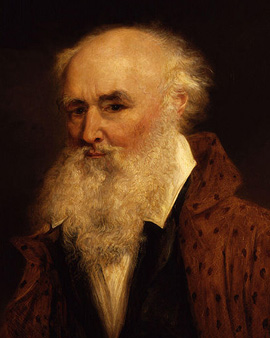The London painter and engraver James Ward, born in London in the late 18th century, was commissioned by the British government over a period of six years to paint a gigantic picture of the Battle of Waterloo entitled "Allegory of Waterloo", which is still considered lost today. The work also brought Ward neither special praise nor the hoped-for financial success. Some heavy family strokes of fate - the death of his first wife and one of his daughters - in combination caused Ward to fall into a bitter state of mind. It all began in London in 1769, when he was born as the son of James and Rachael. His older brother, William Ward, was one of the most successful artists of the time and was appointed engraver to the Prince of Wales, the Duke of York and the Royal Academy of Arts in London. James Ward learned the art of engraving from William.
However, he was inspired less by his brother than by his brother-in-law George Morland and later by the Flemish painter Peter Paul Rubens. In addition to the "Allegory of Waterloo", his works include numerous landscape, animal and genre paintings. In the course of his career Ward turned to ever larger landscapes. He reached his artistic peak with the landscape painting of the limestone gorge Gordale Scar, which lies in the Yorkshire region. However, Ward basically earned his money with commissions from wealthy noblemen, for whom he painted their favourite horses or hunting dogs. After the death of his first wife he married again and finally moved to the small town of Cheshunt, where he continued his work and turned to religious subjects. His granddaughter Henrietta Ward became a painter herself. She concentrated on history and genre painting. His great-grandson Leslie Ward was the well-known portraitist and caricaturist of the magazine "Vanity Fair". James Ward died impoverished in 1855 from a stroke.
Ward was considered one of the best artists of his time, especially with regard to his animal paintings. Together with his brother, he made considerable progress in the British art scene. The combination of artistic talent and perfect craftsmanship produced impressive works, which made it to the gallery of the Tate Modern in London, among others.
×





.jpg)
.jpg)
.jpg)
.jpg)
.jpg)
.jpg)
.jpg)
.jpg)
.jpg)
.jpg)
.jpg)
.jpg)
.jpg)
.jpg)
.jpg)
.jpg)
.jpg)
.jpg)
.jpg)
.jpg)
 - (MeisterDrucke-66456).jpg)
 - (MeisterDrucke-66456).jpg)
.jpg)
.jpg)
_-_(MeisterDrucke-1109525).jpg)
_-_(MeisterDrucke-1109525).jpg)
.jpg)
.jpg)
.jpg)
.jpg)
.jpg)
.jpg)
.jpg)
.jpg)
.jpg)
.jpg)
.jpg)
.jpg)
.jpg)
.jpg)
.jpg)
.jpg)
.jpg)
.jpg)
.jpg)
.jpg)
.jpg)
.jpg)
.jpg)
.jpg)
.jpg)
.jpg)
 - (MeisterDrucke-87990).jpg)
 - (MeisterDrucke-87990).jpg)
_-_(MeisterDrucke-1362723).jpg)
_-_(MeisterDrucke-1362723).jpg)
.jpg)
.jpg)
.jpg)
.jpg)
.jpg)
.jpg)
.jpg)
.jpg)
 - (MeisterDrucke-13157).jpg)
 - (MeisterDrucke-13157).jpg)
.jpg)
.jpg)
.jpg)
.jpg)
.jpg)
.jpg)
.jpg)
.jpg)
.jpg)
.jpg)
.jpg)
.jpg)
.jpg)
.jpg)
.jpg)
.jpg)
.jpg)
.jpg)
.jpg)
.jpg)
.jpg)
.jpg)
.jpg)
.jpg)
.jpg)
.jpg)
.jpg)
.jpg)
_-_(MeisterDrucke-582070).jpg)
_-_(MeisterDrucke-582070).jpg)
.jpg)
.jpg)
.jpg)
.jpg)
.jpg)
.jpg)
.jpg)
.jpg)
.jpg)
.jpg)
.jpg)
.jpg)
.jpg)
.jpg)
.jpg)
.jpg)
.jpg)
.jpg)
.jpg)
.jpg)
.jpg)
.jpg)
_1807_(mezzotint)_-_(MeisterDrucke-545735).jpg)
_1807_(mezzotint)_-_(MeisterDrucke-545735).jpg)
_-_Gesprek_in_de_stalRustic_Conversation_(title_on_object)_-_(MeisterDrucke-1357861).jpg)
_-_Gesprek_in_de_stalRustic_Conversation_(title_on_object)_-_(MeisterDrucke-1357861).jpg)
_-_(MeisterDrucke-899047).jpg)
_-_(MeisterDrucke-899047).jpg)
.jpg)
.jpg)
.jpg)
.jpg)
.jpg)
.jpg)
.jpg)
.jpg)
.jpg)
.jpg)
.jpg)
.jpg)
.jpg)
.jpg)
.jpg)
.jpg)
.jpg)
.jpg)
.jpg)
.jpg)
.jpg)
.jpg)
.jpg)
.jpg)
_(recto)_-_(MeisterDrucke-68648).jpg)
_(recto)_-_(MeisterDrucke-68648).jpg)
.jpg)
.jpg)
.jpg)
.jpg)
.jpg)
.jpg)
.jpg)
.jpg)
 - (MeisterDrucke-41801).jpg)
 - (MeisterDrucke-41801).jpg)
.jpg)
.jpg)
 - (MeisterDrucke-15838).jpg)
 - (MeisterDrucke-15838).jpg)
.jpg)
.jpg)
.jpg)
.jpg)
_-_(MeisterDrucke-897287).jpg)
_-_(MeisterDrucke-897287).jpg)
.jpg)
.jpg)
.jpg)
.jpg)
.jpg)
.jpg)
.jpg)
.jpg)
.jpg)
.jpg)
.jpg)
.jpg)
.jpg)
.jpg)
.jpg)
.jpg)
.jpg)
.jpg)
.jpg)
.jpg)
.jpg)
.jpg)
.jpg)
.jpg)
.jpg)
.jpg)
.jpg)
.jpg)
.jpg)
.jpg)






